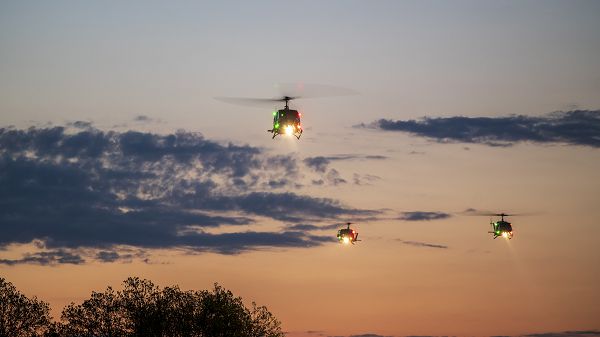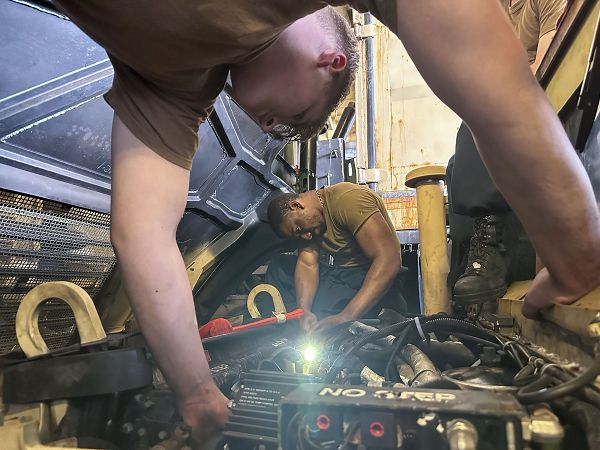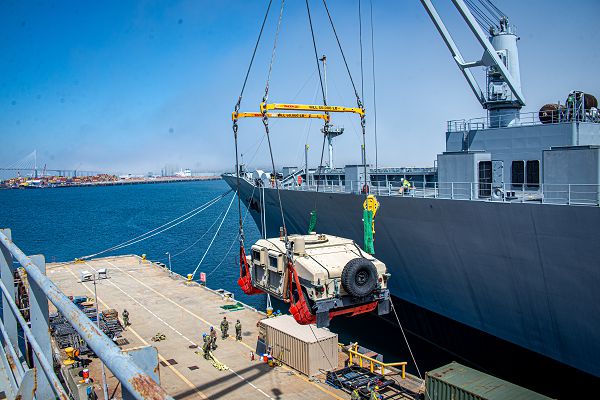- Details
- Hits: 1627

Washington, D.C. (April 6, 2023): In this photo by Master Sgt. Nicholas Priest, three U.S. Air Force UH-1N Huey helicopters from the 1st Helicopter Squadron, Joint Base Andrews, Maryland prepares to land on the National Mall during a routine training flight. The 1st Helicopter Squadron’s mission is to provide priority airlift evacuation for national-level civil and military senior leadership in the Nation’s Capital in an emergency. The Squadron is assigned to the 811th Operations Group that supports the Washington D.C. capital area with routine airlift for the Executive Branch, high-ranking dignitaries, military leaders, and other VIPs. The Wing consists of two squadrons of aircrew and support personnel.
The 1st Helicopter Squadron is the Air Force's largest operational helicopter squadron flying the UH-1N Iroquois “Huey”, the indestructible workhorse of the Viet Nam War. The squadron was first activated in February 1944 as the 1st Fighter Reconnaissance Squadron and flew combat missions in the China-Burma-India Theater during WW II. The Air Force's use of helicopters to transport 'distinguished persons' in the Capital area dates to August 1955 when the Military Air Transport Service was organized at Andrews. The unit also stands ready to help civilian authorities in the event of a disaster.
- Details
- Hits: 1157

Sulu Sea. (April 13, 2023): In this photo by MC2 Joshua Samoluk, Construction Mechanic Seaman Kenneth Foster, left, and Seaman Glenn Thornhill, right, replace an alternator on a Humvee in the well deck of the amphibious transport dock ship USS John P. Murtha. Construction Mechanics repair and maintain heavy construction, tactical, and automotive equipment used to carry out amphibious landings. These skilled technicians diagnose equipment failures including mechanical, electrical, hydraulic, and pneumatic systems and they maintain spare part inventories for equipment repair. In addition to supporting the Naval Construction Forces, Construction Mechanics are in high demand to provide support to Special Warfare and Explosive Ordnance Disposal Units.
- Details
- Hits: 1049

Marine Corps Base, Hawaii. (April 13, 2023): In this photo by Corporal Clayton Baker, Marines carry simulated casualties to safety in a combat evacuation drill during the Corporals Course, a program to teach non-commissioned officers the skills needed to become small unit leaders.
Created in 2009, the Corporals Course focuses on the backbone of the Marine Corps, the non-commissioned officer (NCO). Veteran instructors share their firsthand accounts of leading Marines which helps students relate to their own life experiences. This two-week program teaches basic infantry tactics, communications, land navigation, and military drill and ceremony. The goal is to build a platform for young students to explore the world of the NCO and to learn how to successfully train and lead Marines in combat.
The skills attained at the Corporals Course return to the workplace which improves the core leadership of the entire unit. Eventually, passing the Corporals Course will be a requirement for promotion.
- Details
- Hits: 1676

Long Beach, California. (April 10, 2023): In this photo by Chief Boatswain’s Mate Nelson Doromal Jr., Sailors assigned to Maritime Expeditionary Security Squadron 11 and Navy Cargo Handling Battalion 14 conduct a lift on/lift off operation aboard SS Cape Inscription, a commercial vessel that is part of the U.S. Naval Reserve fleet.
The Adaptive Force Exercise, held in Port of Long Beach, is part of a series of continuous training events for Navy Expeditionary Combat Forces. The series evaluates the Navy’s ability to deliver “expeditionary logistics,” the unique field of planning, staging, and delivering a diverse mix of cargo to combat situations around the world. This critical mission belongs to the Navy Expeditionary Logistics Support Group (NAVELSG) made up of more than 3,300 personnel assigned to three regiments and seven battalions located throughout the United States.
Headquartered in Williamsburg, Virginia, NAVELSG delivers worldwide expeditionary logistics using active and reserve personnel to do port and air cargo handling missions, distribute fuels, and manage freight terminal and warehouse operations. They also handle dangerous materials and even provide postal services. The NAVELSG team also responds to humanitarian crises and serves as America’s ambassador by creating allies through extending relief efforts to other nations.
Essential to any successful logistics effort is security of people and cargo, a responsibility that falls to Maritime Expeditionary Security Squadron 11. Their primary mission is force protection for deployed troops and physical security of harbors and waterways. The squadron specializes in counterterrorism, harbor and maritime infrastructure defense, and high value target protection. Specialized units deploy worldwide to detect, deter, and defend U.S. units around the globe. Recent assignments include Panama, Korea, Saudi Arabia, Kuwait, Iraq, Afghanistan, Bahrain, the United Arab Emirates, and Egypt.
- Details
- Hits: 1227

Fort Bragg, April 2023 —
Thank you to The Bragg ‘N Barn Thrift Shop for your support!
Yesterday the Bragg ‘N Barn Thrift Shop celebrated its Welfare Grants recipients with a little ceremony, the first since our inception in 1957!
At the ceremony, we rewarded several community organizations that focus on giving back to our active duty members, retirees and veterans and our military families.
We appreciate all the generous donations, because without your contributions none of this would be possible.
Furthermore, we’d like to thank the Fayetteville Observer for coming out and supporting our event. Also, a huge THANK YOU to the wonderful staff at Superior Bakery for their generous donations.
As always the men and women serving as Board of Directors, its employees and the staff at USAG.
- Details
- Hits: 1074

Marine Corps Base Quantico, Virginia. (April 11, 2023): In this photo by James Frank, Marine Corps Corporal Xavier Abreu, an ammunition technician with The Basic School, does front squats while participating in the first Training and Education Command Fittest Instructor Competition held here. The Basic School is where all newly commissioned officers go to become “Leaders of Marines”, a sacred oath taken by those of “exemplary character and integrity who are mentally and physically tough.”
The Basic School at Quantico trains over 1,700 officers each year in a 28-week course during which candidates receive classroom and field training on weapons, tactics, and leadership. This extremely demanding course is divided into three phases: leadership, academics, and military skills. Officer candidates must pass a 15-mile hike, an endurance course including land navigation, and qualify in rifle and pistol marksmanship.
In the classroom, future officers attend lectures on tactical decision making, practice strategies in sand table exercises, and participate in small group discussions of historic battle scenarios. In the field, the future leaders are stressed to the maximum as they negotiate obstacles, manage platoon size actions, and engage in realistic live fire training.
It truly does take a special person to dedicate one’s life to leading Marines.


